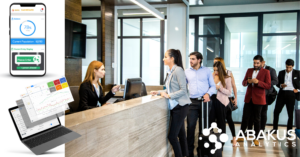How Real-Time Occupancy Management Reduces Queue Wait Times
Long queues can be the bane of any business, whether it’s a bustling retail store, a busy airport, or a popular entertainment venue. Not only do long wait times frustrate customers, but they also result in lost sales, lower satisfaction scores, and operational inefficiencies. Enter Real-Time Occupancy Management, a technology-driven solution that is transforming how businesses manage crowds and optimise customer flow.
By leveraging real-time data, advanced sensors, and analytics, businesses can significantly reduce queue wait times while enhancing overall customer experiences. In this blog, we’ll explore how real-time occupancy management works, its impact on queue management, and why it is essential for businesses across Australia and beyond.
What is Real-Time Occupancy Management?
Real-Time Occupancy Management refers to the use of advanced technology, such as sensors and data analytics, to monitor and manage the number of people in a given space at any moment. This data enables businesses to make immediate adjustments to operations, ensuring optimal crowd control, resource allocation, and customer satisfaction.
Key components of real-time occupancy management include:
- Sensors: Devices such as LiDAR, Stereo video cameras, or Time of Flight sensors to accurately count and monitor foot traffic.
- Data Analytics: Software that interprets occupancy data and provides actionable insights.
- Dashboards: Real-time displays that help staff monitor and respond to crowd levels instantly.

How Real-Time Occupancy Management Reduces Queue Wait Times
1. Predicting Peaks with Real-Time Data One of the biggest challenges in managing queues is anticipating peak times. Real-time occupancy management allows businesses to track customer arrivals and departures minute-by-minute. By analysing this data, businesses can predict when queues are likely to form and take proactive measures to minimise delays.
For example, in retail settings, this could mean opening additional checkout counters during peak hours. In transportation hubs, it might involve directing passengers to less crowded boarding areas.
2. Dynamic Resource Allocation With real-time insights, businesses can allocate resources more effectively. This might involve deploying more staff to high-traffic areas, adjusting the timing of service lanes, or increasing the availability of automated solutions like self-checkout stations.
Queue Management Solutions powered by real-time occupancy data help ensure resources are always available where they’re needed most, reducing bottlenecks and improving overall efficiency.
3. Customer Flow Optimisation Occupancy management systems often include directional flow features, which help guide customers through spaces more efficiently. By reducing areas of congestion and creating smoother pathways, businesses can keep lines moving at a steady pace, ensuring customers don’t feel stuck or frustrated.
For example, some systems use digital signage to direct customers to the shortest queues or redirect them to less busy areas.
4. Automated Alerts for Staff Real-time occupancy systems can send automated alerts to staff when queues are building beyond acceptable levels. These alerts ensure immediate action, such as opening a new service counter or deploying floor staff to assist customers, reducing the risk of prolonged wait times.
5. Improved Customer Communication Real-time data can also be used to improve transparency with customers. For example, displaying real-time wait times on screens or apps can set clear expectations and reduce frustration. Customers are more likely to remain satisfied if they know what to expect.
Real-World Applications in Australia
People Counting Solutions Australia is seeing rapid adoption of real-time occupancy management systems across multiple sectors. Here are some examples:
- Retail: Shopping centres and supermarkets use real-time occupancy data to optimise staffing levels and ensure quick checkouts. During peak holiday seasons, these systems have proven invaluable for reducing wait times and increasing customer satisfaction.
- Transportation: Airports and train stations leverage occupancy data to manage boarding queues, security checkpoints, and ticketing counters. By directing passengers to less crowded areas, they enhance efficiency and safety.
- Hospitality and Entertainment: Hotels, restaurants, and venues use these systems to monitor occupancy limits and reduce queues at entry points, elevators, or service counters.
- Public Spaces: Libraries, museums, and government offices utilise real-time occupancy solutions to manage visitor flow and ensure compliance with safety regulations.
The Technology Behind Queue Management Solutions
Modern Queue Management Solutions rely on a combination of advanced technologies to deliver accurate and actionable insights:
- LiDAR Sensors: These devices provide precise measurements of crowd density without compromising individual privacy.
- AI Analytics: Algorithms process real-time data to identify patterns, predict traffic surges, and suggest actions.
- Cloud Integration: Cloud-based platforms ensure data is accessible to staff and management across devices in real-time.
- Digital Signage: Dynamic displays guide customers and inform them of current queue statuses, enhancing their overall experience.
Benefits of Real-Time Occupancy Management
-
Enhanced Efficiency:
Staff and resources are deployed exactly where they’re needed, minimising wasted effort and maximising productivity.
- Customer Satisfaction: Shorter queues and better communication result in happier customers and improved retention.
- Operational Insights: Long-term data collection allows businesses to identify trends and improve operations over time.
- Regulatory Compliance: In spaces with strict occupancy limits, such as during COVID-19 restrictions, these systems ensure adherence to safety guidelines.
Why Abakus Analytics?
For businesses in Australia, Abakus Analytics is a leader in delivering cutting-edge real-time occupancy management and queue management systems. Our systems are tailored to meet the unique needs of each client, whether it’s a bustling shopping centre, a busy transportation hub, or a high-traffic event venue.
With proven success in implementing People Counting Solutions Australia, we help businesses:
- Reduce queue wait times by up to 30%.
- Improve staff efficiency by 25%.
- Enhance customer satisfaction scores significantly.
Long queues don’t have to be a part of your business’s reality. By adopting Real-Time Occupancy Management and leveraging the power of advanced Queue Management Solutions, you can significantly reduce wait times, improve customer satisfaction, and streamline operations. Whether you’re managing a retail store, transportation hub, or public space, real-time insights are the key to success.
Ready to take the next step? Contact us today to learn how our solutions can transform your business.






